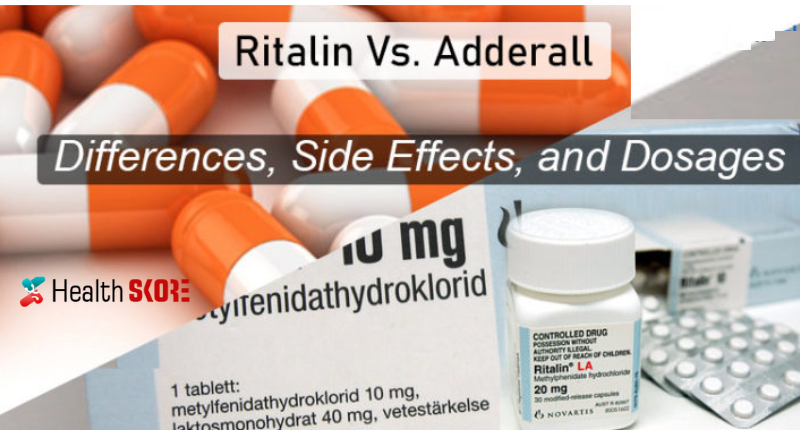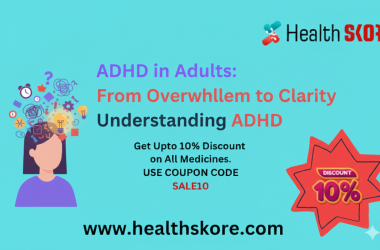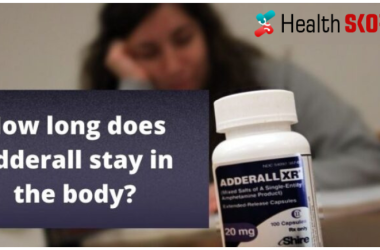Ritalin Vs. Adderall
Ritalin and Adderall are helpful in the treatment of attention deficit hyperactivity disorder. Health care providers also prescribe these medications to people having narcolepsy, a sleep disorder.
Ritalin and Adderall are the brand name versions of two types of central nervous system stimulant medications. Research shows that both medicines are useful in the treatment of ADHD by increasing attention and memory.
In this article, we will see all the similarities and differences between Ritalin and Adderall.
In what form are they available?
Ritalin and Adderall are both available in immediate-release and extended-release forms. However, the extended-release version of Adderall comes as Adderall XR. At the same time, Ritalin extended-release pills come as Ritalin LA (long-acting capsules), and it also comes as SR or sustained-release form.
Adderall is available in the strengths of 5 mg, 7.5 mg, 10 mg, 12.5 mg, 15 mg, 20 mg, and 30 mg of amphetamine salts as immediate-release forms and 5 mg, 10 mg, 15 mg, 20 mg, 25 mg, and 30 mg of amphetamine salts as extended-release formulations.
Ritalin is available in the strengths of 5 mg, 10 mg, and 20 mg of methylphenidate as immediate-release forms, 20 mg of methylphenidate as a sustained-release form, and 10 mg, 20 mg, 30 mg, and 40 mg of methylphenidate as long-acting formulations.
How do they work?
Ritalin contains methylphenidate, which works as a norepinephrine-dopamine reuptake inhibitor. It is a derivate of Benzylpiperidine and phenethylamine, which also shares some part of its structure with catecholamines. Ritalin is a psychostimulant which increases the activity of CNS by inhibiting the reuptake of neurotransmitters dopamine and norepinephrine.
Ritalin is effective in treating ADHD as it increases neurotransmitter activity in the systems that lack action due to the disorder. By increasing the effects of dopamine and norepinephrine, Ritalin improves the activity of the central nervous system and produces effects such as improved attention, increased alertness, and combated fatigue.
Adderall, on the other hand, contains amphetamine, which also acts primarily by increasing the activity of dopamine and norepinephrine neurotransmitters in the brain. It also triggers the release of some other hormones such as epinephrine and neurotransmitters such as histamine and serotonin as well as the synthesis of some neuropeptides such as cocaine and amphetamine-regulated transcript (CART) peptides.
While Ritalin contains the only methylphenidate, Adderall contains two different salts of amphetamine, dextroamphetamine, and levoamphetamine. Both these salts bind to the same biological targets, differing in their binding affinities.
Adderall helps alleviate the symptoms of attention deficit hyperactivity disorder and narcolepsy by increasing the activity of dopamine and norepinephrine neurotransmitters in the brain, which results due to the interactions in neurons with vesicular monoamine transporter 2 (VMAT2) and human trace amine-associated receptor 1 (hTAAR1).
Who needs them?
A health care provider may prescribe you Ritalin or Adderall when you are diagnosed with attention deficit hyperactivity disorder as a part of a complete treatment plan that includes behavioral therapies and counseling.
According to the Children and Adults with Attention Deficit Hyperactivity Disorder (CHADD) charity, a complete treatment plan for ADHD include:
- Education about the disorder and its causes
- Learning about treatment and diagnosis
- Medications such as Adderall and Ritalin
- Behavioral therapy to teach how to manage ADHD symptoms
- Changes to a person’s knowledge to account for ADHD
- General mental health counseling for the family and individual
The AAP (American Academy of Pediatrics) recommends a combination of behavioral therapy and medicine for children above six years.
For children under the age of six years of age, doctors only recommend behavioral therapies as it can be as effective as medications.
Cost, availability, and insurance?
Cost:
Prices of the medications can vary widely, so it’s easy to get Adderall or Ritalin at online pharmaceuticals or local pharmacies. In general, the extended-release formulations of both medicines are usually more expensive than immediate-release ones.
Per pill cost of the Adderall, immediate-release pills is about $5-$7 while that of Ritalin is $3-$7 in the United States. Comparatively, you can get Ritalin at lesser costs than Adderall.
Availability:
Ritalin and Adderall both are available in the immediate-release and extended-release formulations. Ritalin also comes in a suspended release tablet form. Both medications are readily available in the local market or at online pharmacies.
Insurance:
Insurance plans vary from place to place. Do check your insurance plan to know whether your medication gets covered under it. Generally, most of the insurance plan includes both Adderall and Ritalin. But your plan may have different policies.
Drug features: similarity or difference?
- Adderall is the brand version for amphetamine, while Ritalin is the brand version for methylphenidate.
- The FDA (Food and Drug Administration) classifies both Adderall and Ritalin as the schedule-II controlled substances under the Controlled Substance Act of America.
As both medications are stimulants, they have similar effectiveness and side effects. - A meta-analysis of 2018 demonstrates that Ritalin is best for the treatment of children or adolescents with ADHD.
- Being stimulants, they both help improve attention and focus and reduce impulsivity and hyperactivity.
- Although they both have similar effects and work in the same way, the primary difference is that Ritalin works more quickly than Adderall, and it reaches its peak performance earlier, having a shorter half-life.
Can people use them together?
A health care provider would generally not advise you to take Ritalin and Adderall together.
No clinical research shows any relevant data on how these two medicines interact with each other. As both of them are stimulants and work similarly, taking them together can have additive effects and could increase the chances of developing significant complications and side effects.
What should the medical conditions or symptoms be for taking Adderall or Ritalin?
Health care providers prescribe central nervous system stimulants like Adderall or Ritalin only to people who have been diagnosed with attention deficit hyperactivity disorder or narcolepsy.
Attention-deficit hyperactivity disorder is a medical condition in which you have differences in brain development and activity that affects attention, self-control, impulsivity, and hyperactivity. A person should take Ritalin or Adderall if they have the following symptoms of ADHD:
- Impulsiveness
- Poor management skills
- Disorganization
- Prioritizing problems
- Lack of focus or concentration
- Trouble multitasking
- Excessive restlessness
- Low frustration tolerance
- Hot temper
- Frequent mood swings
Above are some of the most common symptoms of ADHD, which may require medications like Ritalin or Adderall. However, there may be other symptoms of the disorder depending upon different individuals.
Is it dangerous to use them together?
It can be dangerous to use Adderall and Ritalin together as they both are central nervous system stimulants, and their concomitant use can cause additive effects of a stimulant, thus, causing unwanted severe side effects.
Drug interactions?
Ritalin and Adderall both contain similar ingredients and act in the same way in the brain. They also interact with the same drugs to produce similar kinds of effects. Frequent interactions of Adderall include:
- Acidifying agents
- Adrenergic blockers
- Alkalinizing agents
- Tricyclic antidepressants
- CYP2D6 inhibitors
- Serotonergic drugs
- MAO inhibitors
- Antihistamines
- Antihypertensives
- Proton pump inhibitors
- Veratrum alkaloids
Frequent interactions of Ritalin include:
- MAO inhibitors
- Antihypertensive drugs
- Halogenated anesthetics
Ritalin has lesser interactions when compared to Adderall, as the medication has quick absorption and elimination cycle.
Are these drugs safe to take if I am pregnant or breastfeeding?
Adderall and Ritalin are not safe to take during pregnancy. Taking Adderall during pregnancy includes the risks of premature birth, low birth weight, and withdrawal symptoms in the infant. Taking Ritalin during pregnancy, especially in the first trimester, has a higher risk of heart defects in the infants.
No clinical studies suggest the adverse effects of Adderall while breastfeeding. It does not affect the nursing infant. However, the mother actively abusing Adderall should not breastfeed as it can have several unwanted effects on the baby. Ritalin also passes through the breastmilk but at a shallow level. Mothers taking the medication at recommended dosages can breastfeed. However, like Adderall, higher doses or abuse of Ritalin by the mothers is not advisable.
Stages of dose?
Childhood:
Adderall and Ritalin are not for children below three years of age.
Children 3-12:
Give 2.5 mg of Adderall per day.
Give 5 mg of Ritalin per day.
Teenage:
Children 13-19:
Give 5 mg of Adderall per day.
Give 5-10 mg of Ritalin per day.
Young age:
Aged 20-60:
Give 10-20 mg of Adderall per day.
Give 20-30 mg of Ritalin per day.
Old age:
Above 65:
Ritalin and Adderall are not recommendable for people above 65 years as the medication can produce severe side effects in geriatric patients.
Side effects of Ritalin vs. Adderall?
Ritalin and Adderall have similar side effects, including:
- Headache
- Irritability
- Fast heartbeats
- Anxiety
- Loss of appetite
- Stomach upset
- High blood pressure
- Trouble sleeping
- Skin rash
- Tremors
- Restlessness
- Mood swings
- Tics
- Diarrhea
- Constipation
- Nervousness
- Hives
- Nausea
- Stomach pain
- Dizziness
Both the medicines also contain warnings related to risks of heart problems, mental health issues, seizures, vision problems, and circulatory problems in the toes and fingers.
Adderall may have some effects on men like impotence, change in sex drive, longer erections, or frequent erections. Some people taking it might also have rhabdomyolysis and hair loss, while Ritalin has very little or no risk of these effects.
Precautions of Ritalin vs. Adderall?
The general precautions for using Adderall and Ritalin include:
- The medications have a high potential for addiction and abuse. However, younger people and adults abuse Adderall more than Ritalin as the former has a more significant high and also helps students with improved memory and concentration.
- People with heart problems should not use Adderall or Ritalin as they both have a risk of stroke, myocardial infarction, or sudden death.
- CNS stimulants like Ritalin and Adderall can cause an increase in the blood pressure and heart rate, causing hypertension or tachycardia.
- They may exacerbate the symptoms of thought disorder and behavior disturbances.
- Adderall and Ritalin impair the ability to engage in potentially hazardous activities like driving or operating machinery.
- Stimulants like Ritalin and Adderall have been associated with the risk of long-term suppression of growth in younger people.
What is better, Ritalin vs. Adderall?
As we have been discussing above, both Adderall and Ritalin are central nervous system stimulants that work similarly in the brain for producing the effects of increased alertness and improved concentration.
It is not easy to say which one is better when comparing Ritalin vs. Adderall as different people have different effects on the same medication. However, if you want a medicine that has more prolonged effects and you need not take the doses every four to six hours, Adderall extended-release form is the best for you as its effects last for more than 12 hours while the effects of Ritalin long-acting pills last for 6-10 hours.
Some people want a medication with lesser side effects and a low risk of abuse and addiction. In that case, Ritalin is the best medicine for you as its half-life and elimination period is less than that of Adderall.
The most prescribed medicine in Ritalin vs. Adderall by doctors is Adderall, as it was the 45th most prescribed medication in the United States, leaving Ritalin behind at 47th position in the year 2016. Doctors consider several factors while making a decision for prescribing stimulant medication to people with ADHD






